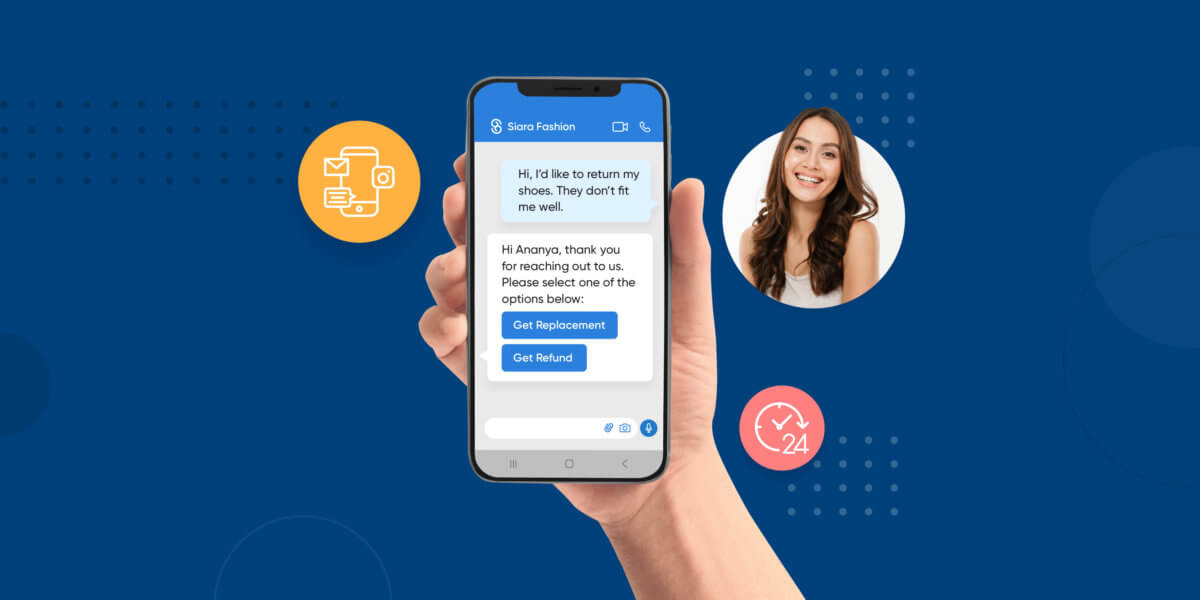Delightful Holidays Await: Hyper-Personalised Campaigns with Expert Customer Support

Delightful Holidays Await: Hyper-Personalised Campaigns with Expert Customer Support
The holiday season is a busy and competitive time for marketers. Consumers are bombarded with offers, discounts, and promotions from various brands, making it harder to stand out and capture their attention. How can you create campaigns that resonate with your audience and drive conversions?
The answer is hyper-personalisation.
Hyper-personalisation is the process of delivering highly relevant and tailored content and messages to each individual customer, based on their preferences, behaviour, and needs. It goes beyond the basic segmentation and personalisation techniques, such as using the customer’s name or location, past hopping history and leveraging data and artificial intelligence (AI) to create unique and engaging experiences across multiple channels.
In this blog post, we will explore why hyper-personalisation matters during the holidays, how to leverage customer data, create customer personas, tailor content and messaging, and use automation and AI to optimise your campaigns. We will also share some tips on how to measure and improve your campaign performance.
Download our ebook to learn more about how to craft hyper-personalised campaigns for the holiday season using Voice AI.
Download the ebook
Why Hyper-Personalization Matters During the Holidays
The festive season presents a golden opportunity for marketers to engage with their customer base and boost sales. As reported by Statista, global retail e-commerce sales hit 1.1 trillion U.S. dollars in 2020 during the holiday period, and for 2021 a growth of 1.3 trillion U.S. dollars and this number has just increased.
However, amidst the festive cheer, marketers grapple with heightened challenges like intensified competition, elevated customer expectations, and fleeting attention spans. In a landscape where customers encounter a barrage of daily marketing messages and have an abundance of choices and channels, the key to winning their loyalty lies in delivering personalised and relevant experiences aligned with their specific needs and preferences. A staggering 71% of consumers express frustration when confronted with an impersonal shopping experience, according to Segment
Enter hyper-personalization—a powerful strategy enabling marketers to establish individualized connections with each customer. This approach ensures the delivery of tailor-made offers at the opportune moment and through the most effective channels.
The adoption of hyper-personalization not only cultivates a one-to-one relationship but also serves as a catalyst for enhancing crucial key performance indicators (KPIs). These include improvements in click-through rates, conversion rates, customer satisfaction, retention, and the overall lifetime value of the customer. In a holiday season marked by a digital deluge, hyper-personalization emerges as the beacon guiding marketers towards a more impactful and resonant engagement with their audience.
As per findings from Epsilon, 80% of consumers exhibit a higher likelihood to make a purchase when engaged with a brand offering personalised experiences. Additionally, an Accenture study reveals that 91% of consumers are more inclined to patronise brands that demonstrate recognition, recall, and deliver pertinent offers and recommendations.
Leveraging Customer Data
The cornerstone of achieving hyper-personalisation lies in customer data. Devoid of data, marketers face challenges in comprehending their customers’ identities, desires, and behaviours. Data serves as the driving force behind hyper-personalisation, empowering marketers to segment their audience, construct customer personas, customise content and messaging, and refine their campaigns.
Yet, not all data holds equal significance. Marketers must adeptly collect and scrutinize data from diverse sources and channels, including web, email, social media, mobile, CRM, and loyalty programs. It is crucial to ensure the accuracy, completeness, and currency of the data while adhering to data privacy and security regulations like GDPR and CCPA.
To harness customer data effectively, marketers turn to data management platforms (DMPs) and customer data platforms (CDPs). These platforms facilitate the collection, storage, integration, and analysis of customer data from various sources, presenting a unified and comprehensive customer view.
Additionally, they empower marketers to activate the data, employing it to craft and deliver hyper-personalised campaigns across multiple channels. Even analysing customer engagement– queries, and past purchases can help you understand customer behaviour and based on that what campaign will convert.
Creating Customer Personas
Customer personas serve as imaginative representations of your ideal customers, constructed from the data and insights you’ve amassed. These personas offer a deep understanding of your customers’ demographics, psychographics, motivations, pain points, goals, and challenges, aiding in audience segmentation and enabling tailored content and messaging for each persona.
Developing customer personas entails engaging in market research, conducting customer surveys, interviews, and focus groups. Additionally, data from DMPs and CDPs, along with tools like Google Analytics, Facebook Audience Insights, and HubSpot, are analyzed to discern patterns and trends. LinkedIn is a very important social media platform for building customer personas when it comes to B2B marketers.
Rather than building a vague persona, based on work experience, title, and demographic will be helpful for marketing but not for creating hyper-personalised campaigns. It is better to select a couple of profiles from LinkedIn and build a persona by including their name, photos and other details.
Then pick the common factors among the users to start working on the campaign.
An effective customer persona should encompass essential details, including:
1. Name and photo
2. Demographics (age, gender, location, education, income, etc.)
3. Psychographics (personality, values, attitudes, interests, lifestyle, etc.)
4. Motivations (factors driving their purchase decisions)
5. Pain points (challenges or problems they encounter)
6. Goals (what they aim to achieve)
7. Challenges (obstacles or barriers they face)
8. Preferred channels (online and offline platforms where they spend time)
9. Buying journey (how they discover, research, evaluate, and make purchasing decisions for your product or service)
Tailoring Content and Messaging
Once you’ve crafted your customer personas, leverage them to customise your content and messaging for each persona. This involves creating and delivering content and messages that resonate with each persona, offering relevance, value, and engagement tailored to their unique needs, preferences, and behaviours. This also involves targeting customers on their preferred communication channel like WhatsApp.
When customising your content and messaging, consider the following factors:
1. Channel
Opt for the most suitable channel to reach each persona, considering where they spend their time and how they consume information. Choices include email, SMS, push notifications, social media, web, or mobile apps for communication. You can even leverage conversational advertising or WhatsApp commerce for the same.
2. Format
Select the optimal format to present your content and message based on the channel and the nature of the information you wish to convey. Formats may include text, images, videos, audio, infographics, ebooks, webinars, conversational ads, WhatsApp catalogue campaigns or podcasts.
3. Tone
Tailor the tone to express your content and message, aligning it with the persona and the context. Whether formal, informal, friendly, humorous, holiday-themed or professional, the tone should resonate with your customers.
4. Timing
Choose the best time to send your content and message, considering the persona and the stage of their buying journey. Utilise triggers such as actions, events, catalogues or dates to deliver your content and message at the opportune moment.
The Role of Automation and AI
Automation and AI play integral roles in the realm of hyper-personalization, facilitating marketers in scaling and refining their campaigns while ensuring the delivery of personalised and pertinent experiences to each customer. These technologies contribute significantly to various aspects:
Data collection and analysis
Automation and AI assist marketers in gathering and analysing customer data from diverse sources and channels – like WhatsApp and Voice medium. They provide valuable insights and recommendations on how to effectively segment, target, and engage with customers.
Content creation and delivery
Marketers benefit from automation and AI in crafting and delivering content and messages tailored to each customer’s persona, preferences, and behavior. Technologies like natural language generation (NLG), natural language processing (NLP), and computer vision (CV) enhance the customization process.
Campaign optimisation and testing
Automation and AI prove invaluable in optimizing and testing campaigns through techniques such as A/B testing, multivariate testing, and machine learning (ML) algorithms. These technologies enable marketers to measure and enhance campaign performance and return on investment (ROI). Conversational AI enabled on WhatsApp gives you the freedom to test your campaigns, and optimise the conversation flow.
Responsible Use of Auto-Replies
Auto-replies offers a convenient means of communication, especially when you’re occupied or away. However, they pose certain risks, including:
- Sending irrelevant or inappropriate messages.
- Bombarding customers with too many or too few messages.
- Offering impersonal or generic responses.
- Providing inaccurate or outdated information.
To use auto-replies responsibly, adhere to these best practices:
- Clearly communicate expectations, specifying when you’ll return and expected wait times.
- Offer alternative contact methods for urgent or specific assistance.
- Maintain a friendly, polite, and professional tone aligned with your brand’s voice.
- Include a “what next” option, like a call to action, resource link, or feedback form.
- Enhance auto-replies with visuals, emojis, or GIFs to infuse personality and humour.
- Personalise messages by incorporating the customer’s name or location for a more human touch.
Conversational AI your Hyper Personalisation Partner
Unlocking the potential of hyper-personalization is the cornerstone of crafting impactful campaigns that resonate and drive conversions, especially during the festive season. By harnessing customer data, crafting detailed personas, customizing content, and integrating automation and AI, a unique and engaging experience can be curated for each customer across various channels and touchpoints. This approach facilitates continuous measurement, optimization, and utilization of insights to refine strategies.
Yet, achieving hyper-personalization is no small feat, demanding substantial time, effort, and resources. This is where a robust and dependable ally comes into play, and that ally is conversational AI.
Conversational AI, a cutting-edge technology, empowers the creation and deployment of intelligent chatbots and voice assistants. These seamlessly communicate in natural language, delivering personalised information, offers, and recommendations to customers. Partnering with conversational AI ensures that your hyper-personalisation goals are not just met but exceeded, making your holiday campaigns truly exceptional.
.






